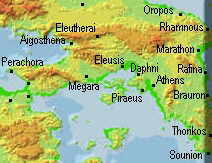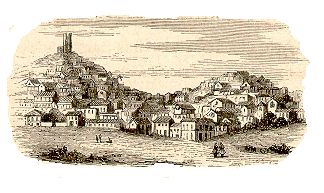

 Officially part of Attica today, Megara has historically
been an enemy of Athens. Modern Megara has not been touted much by Greece
as an attraction for tourists. It does not even get mentioned in the
Rough Guide to Greece or Frommer's Greek guide.
Officially part of Attica today, Megara has historically
been an enemy of Athens. Modern Megara has not been touted much by Greece
as an attraction for tourists. It does not even get mentioned in the
Rough Guide to Greece or Frommer's Greek guide.
A city of almost 20,000 inhabitants, Megara is bypassed
by the national road into the Peloponnese. The stop is 42 km from
Athens, but I am not sure what bus one would need to take from Athens to
get there. The bus that leaves Athens for Eleusis continues west after
making that stop, and it may be that it goes on to Megara, but I am cannot
be sure. Unfortunately the tour guide books do not give any information
on this.
The Megarid and the location of Megara
The plain of Megara is not extensively arable.
There exists around 100 sq. kilometers of good farmland which was most likely
devoted fully to wheat and barley during the city's early existence.
It forms roughly a triangle shape, widest as the plain reaches the sea, though
there are no rivers that drain it. See the satellite
map of Attica
to get a better understanding of the rocky area. The plain lies between
the Cerata/Pateras mountain range to the east and the Gerania range to the
west. These ranges defined the political boundaries of Megara, although
in the archaic period the Sanctuary of Hera at Perachora
, and even the entire Perachora peninsula, fell under the control of
Megara (it later became a Corinthian possession and today it is officially
part of the prefecture of Corinth). During that same period of time,
Megara may have controlled the plain to the west of Gerania all the way to
the isthmus. Population estimates of ancient Megara at its height (during
the fifth century BC) place the number of inhabitants at not over 40,000.
The plain would have been able to supply food for a little over half that
number and the rest would have been fed using imported grain. The number
of citizens that Megara could have supported was dwarfed by the other states
around it: Corinth, Boeotia, Athens. It would have made Megara one of
the smallest city-states of Greece. The only natural resources from
the area were the deposits of salt found on its south coast.
Modern Megara is located precisely above ancient Megara.
A number of archaeological emergency excavations have led to the discovery
of many artifacts and sites, but these are not visible to the public if they
were even preserved at all. Notable discoveries include parts of the
4C BC wall which surrounded the city as well as part of the wall's towers.
The archaeological remains that have been kept in Megara are found in the
local High School, but I do not know if they are accessible to the general
public. The one identifiable landmark that has been found is the so-called
Fountain house of Theagenes. It was never actually lost though and it was
partially excavated in the 1890's.
History
 Megara may have been under Athens' control in the Bronze
Age. Homer listed them together in his catalogue of ships. But in the
Geometric period it was independent. Megara was well known for its numerous
colonies that included Chalcedon and Byzantium. The city hotly contested
the island of Salamis with Athens and in c 570 BC lost it to the tyrants
of Athens. About the same time Perachora was lost to Corinth. The Megarians
fought at Plataea, sending 3000 troops, and it was at Megara that the Persians
stopped, unable to continue past the Isthmus.
Megara may have been under Athens' control in the Bronze
Age. Homer listed them together in his catalogue of ships. But in the
Geometric period it was independent. Megara was well known for its numerous
colonies that included Chalcedon and Byzantium. The city hotly contested
the island of Salamis with Athens and in c 570 BC lost it to the tyrants
of Athens. About the same time Perachora was lost to Corinth. The Megarians
fought at Plataea, sending 3000 troops, and it was at Megara that the Persians
stopped, unable to continue past the Isthmus.
Before the Peloponnesian War, Megara sided with Athens
and the Athenians built long walls from the town down to the port of Nisaea.
But they soon turned on the Athenians and in 432 Pericles' famous Megarian
Decree helped to cause the war by keeping all Megarians from Attic markets
and harbors.
During the war, the Athenians invaded Megara's lands often and even blockaded
the city from the sea. Though the Athenians managed to take the port
of Nisaea, they never managed to break into the city itself. In the
fourth century, Megara was in control of the port of
Aigosthena
, well north of the city.
Throughout Antiquity, Megara was not thought very highly of.
Pausanias said that they were the only Greek people whom even the emperor
Hadrian could not make thrive. Strabo said that the soil was very sterile.
Theophrastus said the land around it was poor. Isocrates even said that
the Megarians "farmed rocks." But the city retained its fortifications
until the 5th C AD.
Megara was also the birthplace of both Theognis the elegiac
poet Eukleides the sophist.
Let's go east back to Attica . Let's go west towards the Peloponnese .